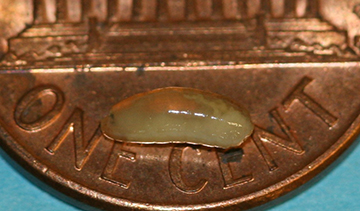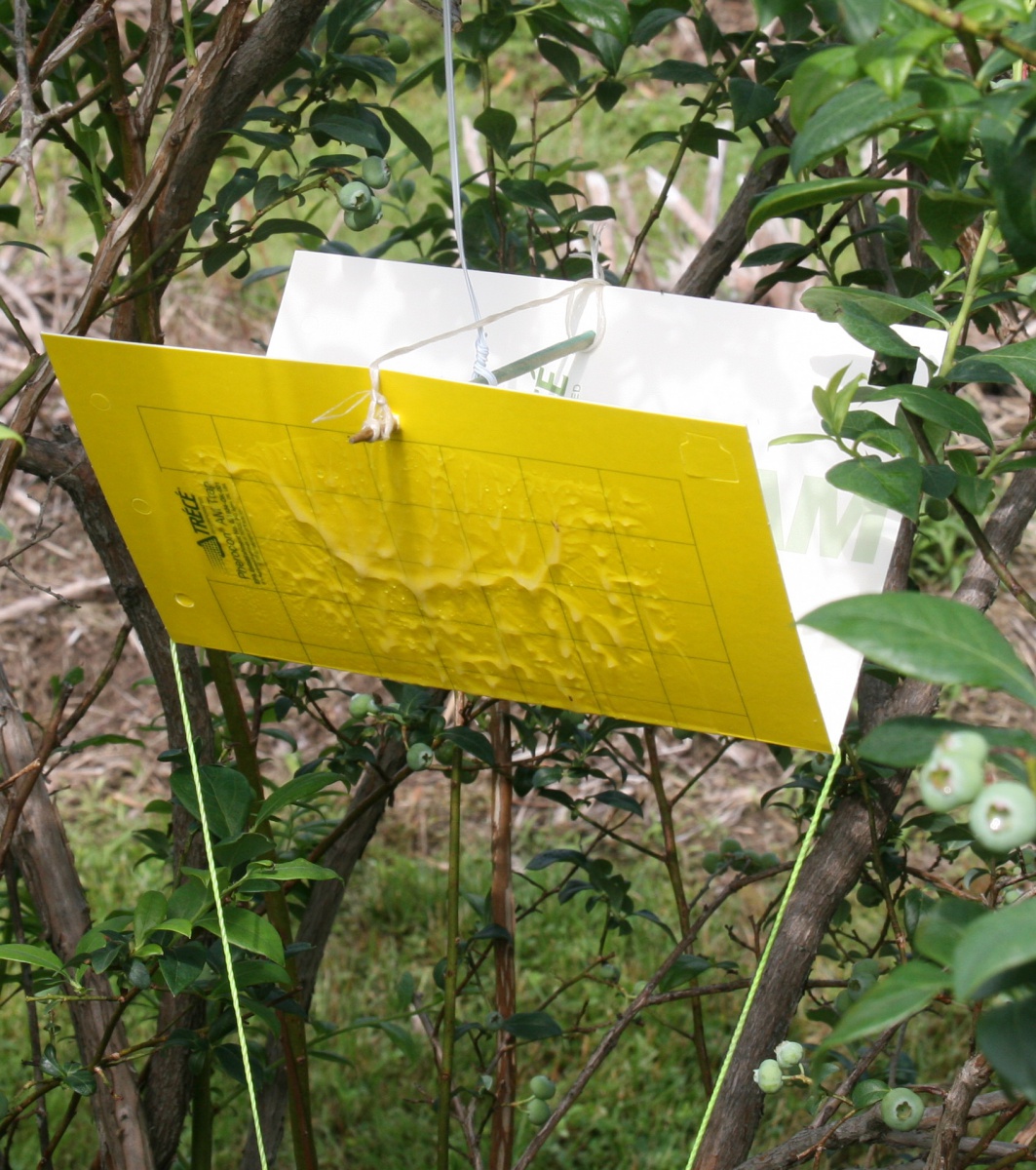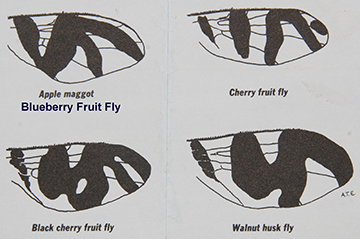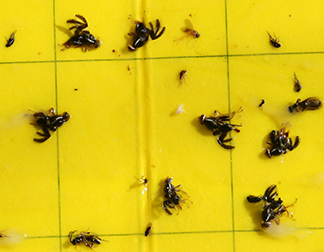Blueberry fruit fly, Rhagoletis mendax Curran is a native insect that looks almost identical to apple maggot, except that it attacks blueberries, not apples. It is usually slightly smaller than apple maggot, with the adults typically being 3-4mm long (roughly 1/8 inch). The insect is also known as blueberry maggot. It occurs statewide. Their numbers seem to fluctuate greatly from location to location, and they can build up to very high levels over time, if not managed. In our 2010 trapping at 16 New Hampshire farms, zero blueberry fruit flies were trapped at eight sites. Four had 100 or more flies trapped over the season, and one had over 1000.
There are inexpensive traps available for monitoring blueberry fruit fly numbers. By using them, blueberry growers can avoid needless insecticide applications, and/or respond by implementing controls when the population builds. They are easy to use, and work well if placed properly.
Life History and Damage
The insects overwinter in the soil in the pupal stage. The pupae are dark brown and oval, about 4 mm long. Adult flies emerge about the time that the first blueberries start to turn blue. Usually that is late June or early July. Females mate and feed on honeydew on foliage for seven to 10 days, before starting egg laying. They lay their eggs in the fruit, usually one at a time, just under the skin. They continue to feed and lay eggs for several weeks. Numbers are usually the highest from late June through mid-July, and sometimes flies are still active as late as early September. They are especially active in spots that are protected from the wind, like the interior of bushes. In lowbush blueberry fields, they are often in spots protected by taller nearby vegetation.
Larvae are whitish maggots, which hatch from the eggs and feed inside the berry, turning the flesh mushy. After about 20 days, they have completed their feeding and drop to the soil to pupate. There is only one generation per year.

Trap Types
There are several commercially available traps:
• sticky red spheres
• sticky green spheres
• (yellow) Trece baited Pherocon AM traps
Even though they are called traps, it is difficult to control the insect with these. They are used to monitor the pest population. Eventually, an insecticide-treated red sphere (the “Curve Ball”) may be commercially available as a control option. If you do wish to control the flies with sticky traps, preliminary research suggests that in a heavily infested site, you would need one or more (properly hung) traps in each bush, depending on bush size and fruit load.
Red Spheres
The original research on these traps used Sherwin Williams’ “Tartar Red, Dark” enamel, but any dark red color will work. University of Massachusetts researcher Ronald Prokopy and his students found that black worked well, but it is extremely difficult to see and count the flies on a black surface, so we don’t use that color. Some of the commercially available traps are heavy, made of wood. Others are hollow, lightweight plastic. Most are 3 inches in diameter. When it is time to hang them, you apply a sticky coating called Bird Tanglefoot or Tangletrap. If used and stored properly, the traps can be used for many years. (At the end of the season, scrape off much of the sticking agent, and then store them in a heavy sealed plastic bag.) New Hampshire field research in 2010-11 proved that adding the commercial odor lures to the red spheres significantly increases the catch. The odor lure is usually attached within a few inches of the sphere.
Green Spheres
If used in combination with the odor lures, green spheres catch about the same number of blueberry fruit flies as the baited red sphere traps. One advantage they have over the red traps is that the black wing bands that we use to identify the catch are very easy to see on the light green traps, compared to the dark red traps.
The odor lures to add to red or green sphere traps produce ammonia, a natural feeding attractant for blueberry fruit fly and its relatives. If you do purchase lures, be sure that they are intended for blueberry fruit fly.
We have not compared the effectiveness of green sphere traps without ammonia lures to other types of traps. In our 2010 experiments, 1) green spheres with odor lures and 2) Trece baited yellow AM traps deployed in V position were equally effective. Both were more effective than the red sphere traps. Flies are much easier to count on the yellow traps, but the yellow traps need replacement every 2 weeks.
Yellow Rectangle Traps
The traps we use are “Trece baited Pherocon AM traps”, which are 9 x 5 ½ inches. These are designed for apple maggot, cherry fruit fly, walnut husk fly, and blueberry fruit fly. There are other yellow traps available, by other manufacturers, or for other purposes. Although they all could look yellow to us, other types may be ineffective for blueberry fruit fly, because they must look correct to the flies, which can see different wavelengths from us. Trece makes other traps that have the same pigment, but are unbaited (no feeding attractant mixed into the sticking agent). These probably are less effective that the baited types. Yellow sticky cards designed for greenhouse use are very small and we have not tested them for this insect.
These traps are made of cardboard. They are inexpensive, but last only about 2 weeks. After that, they become soggy and ineffective. To place them most effectively for blueberry fruit fly requires a slight modification: Hang them with the long axis parallel to the ground, in a V position, with the yellow side down, and the unpainted white side up (see photo). We often use a small diameter sharpened bamboo stake to hold them open. We loop an anchoring string over the trap and down to a low limb or stake. These traps already have an odor incorporated in the sticking agent (unless you buy the unbaited
ones…don’t), so you do not need to add odor capsules.

Making Your Own Red Sphere Traps
We do not recommend this for commercial growers, because you don’t know whether or not your home-made traps will work effectively, so you would be gambling your crop on its success. Backyard growers might feel differently, and could use croquet balls painted dark red, with strong screw-eyes inserted at the top. Making yellow traps is much less likely to work, since we can’t tell (except by experimentation) if the shade of yellow is attractiveor not to the target insect. The same goes for green sphere traps.
Where to Buy Traps
Gempler’s
P.O. Box 44993
Madison, WI 53744-4993
1-800-382-8473. FAX: 1-608-662-3360.
www.gemplers.com
Great Lakes IPM
10220 Church Rd, NE
Vestaburg, MI 48891
1-800-235-0285. FAX: 1-989-268 5311.
www.greatlakesipm.com
Both of these suppliers have traps for various pests of tree fruit, small fruit, greenhouse, vegetable, field and forage crops. They’ve also got sticking agents, insect nets, magnifiers, references and more.
Sticking Agent
The original research on the red spheres used a material called Bird Tanglefoot, which is essentially identical to what is now called Tangletrap. It is composed of polybutenes (97%) and hydrogenated castor oil (3%). Using a flat stick (6” wood garden stake works well) you carefully apply a thin coating over the entire sphere. Do this after you’ve chosen a site to hang it! There are sprayable and brushable forms of the product, but they do not work as well.
Placing and Checking the Traps
Remember that these are primarily visual traps, so they must be hung properly, and kept relatively clean, to work well. For a backyard situation, one trap may be sufficient for monitoring purposes. For a commercial operation, several traps are better, especially if there are multiple blocks and varieties grown. To hold the traps, we often use wooden stakes or pieces of conduit pipe bent into an L position. This is especially important if bushes are heavy with fruit.
In a lowbush blueberry field, hang the traps so that the underside is six to twelve inches above the tips of the blueberry plants. Sheltered spots are the best locations, like downwind from weed bushes or other barriers. If you cull fruit in the field, place some traps close to where you dumped culled fruit (that’s where many flies emerge).
In a highbush planting, we look for a “hole” in a bush with fruit. Hang the trap in the top half of the bush, with fruit relatively close by, but not so close that they get stuck onto the trap. Anchoring the trap can reduce its tendency to blow in the wind. Sometimes we hang traps from branches that are strong enough to handle the weight. When using yellow rectangle traps, place them in a V position (see photo o previous page) and loop a string to an anchor, to keep the trap from tangling in vegetation.
Be sure to place at least one or two traps in your earliest ripening variety, in addition to your other ones.
Set them out when the first fruit are starting to turn blue, or by July 1st, whichever is earlier. Check traps at least weekly. Count and record the number of blueberry fruit flies, and remove them as you count. A small diameter twig works well for this. Usually traps can be removed by early September, unless you have lots of late-bearing bushes.
Identifying the Catch
All of our Rhagoletis flies look similar, with light markings on the body, and black bands on the clear wings. The wing band pattern is distinctive, and can be recognized at a glance (diagrams left). For some of us, a
2X magnifying glass is very helpful. In the photo at right, there are seven BFF’s. If the traps become heavily covered with insects or debris, scrape off as much as you can, and re-apply a thin coating of the sticking agent.


The average pattern of BFF catch is usually similar to this 2011 graph, with the first capture in late June, and peak capture often the second week of July. By August, fly numbers are usually significantly reduced.

Trap Removal and Storage
If you are using traps designed for multiple year use, remove them at the end of the picking season. Scrape off much of the sticky covering and store them in a sealed container [to keep out dirt & dust]. If you use a plastic bag for this, be sure it is heavy, and is stored away from sunlight. Ron Prokopy often scraped with a crescent-shaped piece of plastic cut from a milk jug. A bleach jug piece might be good, too, with a tighter curve. Cardboard yellow sticky traps are not designed for long term use. If you purchase more of them than you can use in one season, you can seal them in a couple of tight plastic bags, and store in a freezer.
Signs
If you are a commercial grower, it is a good idea to use signs to warn your customers not to touch the traps, or get the sticky coating on clothing or hair. This also reduces the chance customers will interfere with your monitoring. On the sign, you might consider pointing out that the traps help you reduce the chance of pest problems. Customers don’t like to read the M word (maggot) when referring to something that attacks the fruit. You might prefer to call it blueberry fruit fly, which is one of its common names.
Thresholds
In lowbush blueberry plantings, Maine Cooperative Extension suggests treating with an insecticide if an average of six or more flies are found per trap in a field. In highbush blueberry plantings, both Massachusetts and Michigan Extension workers suggest treating soon after the first fly is detected. Since the pattern of emergence shows peak numbers relatively early in the season, and then decreasing, it is important to control the flies relatively early. Insecticides may not be required for BFF at all, in many sites, and they may be required only early in the season at many others.
The intervals for any following sprays depend on the insecticides used, and the number of BFF’s caught. You’d discount any flies captured on the traps during the period that an insecticide should be working (see below) and then treat if flies re-appeared on traps after that period.
Michigan State University recommendations suggest:
14 days of control: Imidan (phosmet)
10-14 days: Assail (acetampyrid) or Provado (imidacloprid)
7-10 days: Asana (esfenvalerate), Danitol (fenpropathrin)
5-7 days: Malathion (malathion), Lannate (methomyl)
They do not rate GR-120 Naturalyte fly bait (spinosad plus feeding stimulants), but it has the same active ingredient as Entrust and Spintor, which were listed as 7-10 day materials. Spintor and Entrust are not registered for blueberry fruit fly control. Both are registered for other pests on blueberry. In New Hampshire, this means that people who have private pesticide applicator licenses are allowed to try them for this pest, provided they follow the label instructions for application on blueberry.
Control
Most New Hampshire blueberry growers do not want any maggots in their fruit, but also do not wish to apply pesticides more than is necessary. Customers frequently prefer that fruit be unsprayed, but rarely understand that this might increase the risk of fruit being infested. The best opportunity to knock down the population with pesticides is usually relatively early in their emergence, when fly numbers are climbing, and picking is not yet in full swing. For some growers, spraying must occur on dates that the blueberry patch is closed to picking.
Artificial chemical insecticides usually are very effective as controls. Growers report that organic options (shown with asterisk) frequently are less effective. One under-used option is to mix a feeding stimulant (Nu-lure) with the insecticide. It can improve spray efficacy for most products, by luring the flies to feed on the material. (This is probably not true for GR120 naturalyte bait, which already has a bait in it.) The malathion label still lists the old name (Staley’s Sauce Base) that is essentially the same as Nu-lure. The pre-harvest interval for these pesticides varies from 0 days to 14. This is important to keep in mind, because the period when sprays are effective usually coincides with harvest.
Pesticide options are constantly changing.
• As this was written, options with “excellent” ratings from growers included : Asana, Danitol, Assail, Lannate, Imidan.
• Materials usually rated as “very good” included Sevin and Malathion.
• Materials with lower efficacy ratings from growers included Pyrenone, Surround*, Aza-Direct* and GF-120 Naturalyte fly bait*.
Research (New Jersey, 2005) on the effectiveness of organic spray options showed Aza-direct [azadirachtin; neem extract] was less effective than Pyganic [pyrethrins] or Entrust [spinosad]. The latter two performed as well as Imidan (a synthetic chemical) in this test. In 2011, the organic product GF-120 Naturalyte Fruit Fly Bait completely controlled a very high population of BFF’s at one New Hampshire site that tied the spraying to monitoring with the V-position yellow traps.
Destroying nearby unmanaged blueberries can reduce the chances of having blueberry fruit fly problems. Both serviceberry (Amelanchier spp.) and black chokeberry (Aronia melanocarpa) fruit can serve as hosts, so eliminating these plants nearby might help as well. Sanitation can also help: spoiled fruit should not be dumped in or near the planting. They can contain the pests, which then overwinter in the soil and attack next year’s crop. This is especially common in lowbush blueberry plantings. Although there are native parasites and predators that attack blueberry fruit fly, they do not keep the population under control.
Asterisk * denotes products that are approved for use on organic farms.
This publication was supported in part by IPM grants from the New Hampshire Department of Agriculture, Markets and Food, and the National Institute for Food and Agriculture, United States Department of Agriculture.
Acknowledgements: Thank you to Becky Sideman and Roger Swain for reviewing the manuscript and making valuable comments. Thank you to Suzanne Hebert for layout of the publication. All photographs are by Alan Eaton.
Download the Resource for the complete fact sheet.
